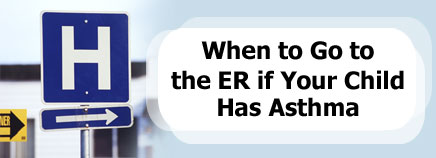
One of the main goals of parents whose kids have asthma is avoiding trips to the emergency room (ER) for breathing problems. But it’s also important to know when going to the ER is the right choice.
You’ll be better prepared to make that decision if you discuss it with your doctor before your child has a severe flare-up. The doctor’s instructions should be included in the asthma action plan. The plan will list specific symptoms that are your cue to go to the ER. If old enough, your child also should know what these signs are.
Know the Early Signs of a Flare-Up
Everyone’s asthma is different. Some kids cough only at night, while others have flare-ups whenever they get a cold or exercise outside.
As you manage your child’s asthma, pay attention to what happens before a flare-up so that you know the early warning signs. These signs might not mean that a flare-up definitely will happen, but they can help you to plan ahead.

Early warning signs of a flare-up can include:
- wheezing
- coughing that’s not due to a cold or a persistent cough
- tightness in the chest
- throat clearing
- rapid or irregular breathing
- shortness of breath with activities
- inability to stand or sit still
- unusual fatigue
- restless sleep
Communicate with your doctor. Be sure to call the doctor at the earliest sign of a flare-up or if you have any other concerns. Being prepared means you might prevent your child’s symptoms from getting worse and can make a trip to the doctor’s office instead of to the ER.
When to Seek Help
Sometimes your child must receive medical care very quickly. If any of the following symptoms happen, see your doctor immediately, go to the ER, or call an ambulance:
- if your child is having constant wheezing
- if your child uses quick-relief medicines (also called rescue or fast-acting medicines) repeatedly for severe flare-up symptoms that don’t go away after 5 or 10 minutes or return again quickly
- if there are changes in your child’s color, like bluish or gray lips and fingernails
- if your child is having trouble talking
- if the areas below the ribs, between the ribs, and in the neck visibly pull in during inhalation (called retractions)
- if your child’s peak flow reading falls below 50% (which is in the red zone of the peak flow) and doesn’t improve after using medicine
Making ER Trips Less Stressful
Planning can make trips to the ER less stressful for you and your child. Here are some tips to try:
- Know the location of your closest ER. If there’s a children’s hospital ER nearby, go there and have the address and phone number handy (written on the asthma action plan, for instance).
- If you have other kids, try to make arrangements with a relative or other caregiver who can take them in an emergency. But don’t let the lack of a babysitter delay your trip to the ER. Someone can always come to the hospital later to pick up your other kids.
- Take a copy of your child’s asthma action plan or a note with the names and dosages of any medicines your child takes to share with the medical staff at the ER.
Following the Asthma Action Plan
Well-managed asthma is rarely life threatening. People who have died from asthma usually hadn’t taken their medicines as prescribed and had a history of repeated severe asthma flare-ups and emergency care.
If you and your child take asthma seriously and work to manage it, you can lessen the chances that your child will need to go to the ER.
It’s important to monitor your child’s asthma using the written asthma action plan your doctor helps you create. This plan will outline day-to-day treatment, symptoms to watch for, and step-by-step instructions to follow during a flare-up.
Some key points of a plan are:
Avoid Triggers
The doctor can help you identify the triggers that might cause asthma flare-ups, such as tobacco smoke, animals, dust mites, mold, pollen, perfumes, aspirin, weather change, cold air, exercise, and respiratory infections.
Take the Long-Term Control Medicines
Your child should take long-term control medicines (also called controller or maintenance medicines) as prescribed by the doctor, even when feeling fine. Skipping doses can cause the lungs to become more inflamed, which can lead to a decrease in lung function. (This can happen without your child even having any symptoms.) It also increases the risk of more frequent and severe flare-ups.
Keep Quick-Relief Medicines Handy
Many kids go to the ER simply because they didn’t have their quick-relief medicines handy. Your child should have quick-relief medicine available at all times. This includes making sure to keep the medicines at school with the nurse, at sporting events, and while traveling.
Be Partners in Asthma Management
As soon as your child is old enough, make sure he or she understands the asthma action plan and the importance of following it. Some kids with asthma, especially teens, resist taking long-term control medicines and rely instead on their quick-relief medicines to help them on an as-needed basis. This is never a good idea and will increase the chances of needing emergency care.
The chances of a serious asthma flare-up can be reduced if parents and kids understand and follow the action plan. And remember to call your doctor even during early flare-ups or if you have questions about your action plan.

